珠宝微课堂第一课——宝石的基本概念What is a gem
- 格式:doc
- 大小:141.50 KB
- 文档页数:3
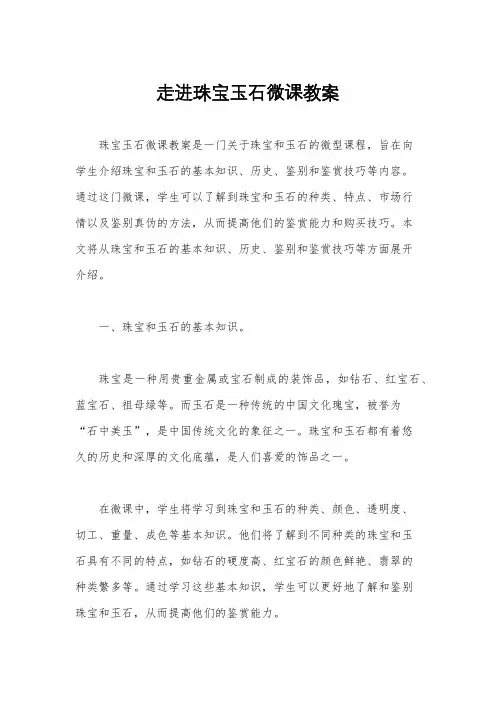
走进珠宝玉石微课教案珠宝玉石微课教案是一门关于珠宝和玉石的微型课程,旨在向学生介绍珠宝和玉石的基本知识、历史、鉴别和鉴赏技巧等内容。
通过这门微课,学生可以了解到珠宝和玉石的种类、特点、市场行情以及鉴别真伪的方法,从而提高他们的鉴赏能力和购买技巧。
本文将从珠宝和玉石的基本知识、历史、鉴别和鉴赏技巧等方面展开介绍。
一、珠宝和玉石的基本知识。
珠宝是一种用贵重金属或宝石制成的装饰品,如钻石、红宝石、蓝宝石、祖母绿等。
而玉石是一种传统的中国文化瑰宝,被誉为“石中美玉”,是中国传统文化的象征之一。
珠宝和玉石都有着悠久的历史和深厚的文化底蕴,是人们喜爱的饰品之一。
在微课中,学生将学习到珠宝和玉石的种类、颜色、透明度、切工、重量、成色等基本知识。
他们将了解到不同种类的珠宝和玉石具有不同的特点,如钻石的硬度高、红宝石的颜色鲜艳、翡翠的种类繁多等。
通过学习这些基本知识,学生可以更好地了解和鉴别珠宝和玉石,从而提高他们的鉴赏能力。
二、珠宝和玉石的历史。
珠宝和玉石作为人类文明的产物,拥有着悠久的历史。
在微课中,学生将了解到珠宝和玉石在不同历史时期的发展和演变。
他们将了解到古埃及人民将珠宝视为神圣的象征,古希腊人民则将珠宝用于装饰和礼物,古罗马人民则将珠宝作为权力和地位的象征。
而在中国,玉石更是被视为吉祥和幸福的象征,被广泛应用于装饰和礼品。
通过学习珠宝和玉石的历史,学生可以更好地了解到珠宝和玉石的文化内涵和历史价值,从而更好地欣赏和鉴赏这些珍贵的宝物。
三、珠宝和玉石的鉴别技巧。
在微课中,学生将学习到珠宝和玉石的鉴别技巧。
他们将了解到珠宝和玉石的真假鉴别方法,如通过肉眼观察颜色、透明度、切工等特征,通过放大镜观察内部包裹物和瑕疵,通过专业仪器测量硬度、密度等指标等。
这些鉴别技巧将帮助学生更好地辨别珠宝和玉石的真伪,避免购买假货和受骗上当。
通过学习珠宝和玉石的鉴别技巧,学生可以提高他们的鉴赏能力和购买技巧,从而更好地选择和购买珠宝和玉石。
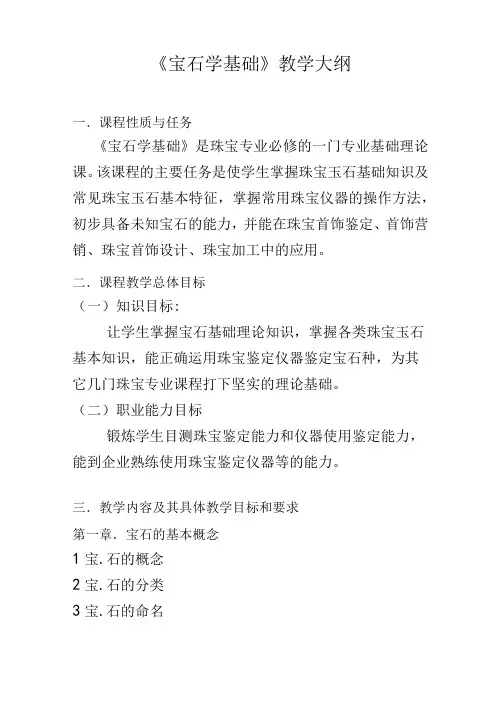
《宝石学基础》教学大纲一.课程性质与任务《宝石学基础》是珠宝专业必修的一门专业基础理论课。
该课程的主要任务是使学生掌握珠宝玉石基础知识及常见珠宝玉石基本特征,掌握常用珠宝仪器的操作方法,初步具备未知宝石的能力,并能在珠宝首饰鉴定、首饰营销、珠宝首饰设计、珠宝加工中的应用。
二.课程教学总体目标(一)知识目标:让学生掌握宝石基础理论知识,掌握各类珠宝玉石基本知识,能正确运用珠宝鉴定仪器鉴定宝石种,为其它几门珠宝专业课程打下坚实的理论基础。
(二)职业能力目标锻炼学生目测珠宝鉴定能力和仪器使用鉴定能力,能到企业熟练使用珠宝鉴定仪器等的能力。
三.教学内容及其具体教学目标和要求第一章.宝石的基本概念1宝.石的概念2宝.石的分类3宝.石的命名4宝.石的属性5宝.石的价值6宝.石的性质要求:宝石的基本概念、分类、属性及价值。
要求学生掌握:宝石的概念、宝石的分类、宝石的命名;了解:跟宝石相关的一些知识,如:地质学基础、结晶学基础、地球化学基础、宝石的物理性质、常用鉴定方法等。
第二章.钻石1.概述2.钻石的基本性质3.钻石真假鉴别要求学生掌握:钻石的一些基本性质、钻石的现状、钻石的真假鉴别;了解:钻石的基本性质、钻石的评价等。
第三章.红宝石和蓝宝石1.概述2.红宝石和蓝宝石的鉴别要求学生掌握:红宝石和蓝宝石的一些基本性质、红宝石和蓝宝石的现状;了解:红宝石和蓝宝石的鉴别。
第四章.绿柱石类宝石1概.述2主.要宝石品种3祖.母绿和海蓝宝石的鉴别要求学生掌握:绿柱石类宝石的一些基本性质、几种主要宝石品种、绿柱石类宝石的现状;了解:绿柱石类宝石的鉴别与评价。
第五章.翡翠1概.述。
2翡.翠的鉴别要求学生掌握:翡翠的一些基本性质、翡翠的鉴别与大体评价;了解:与相似翡翠的鉴别。
第六章.玉石1软.玉2岫.玉3独.山玉要求学生掌握:软玉、岫玉、独山玉之间的区别,软玉、岫玉、独山玉的一些基本性质;了解:软玉、岫玉、独山玉的品种和评价。
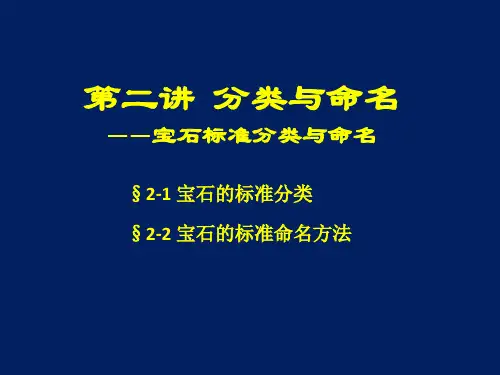
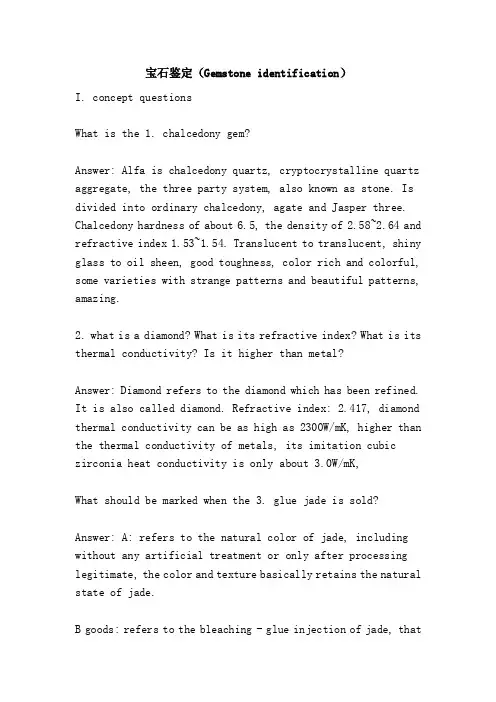
宝石鉴定(Gemstone identification)I. concept questionsWhat is the 1. chalcedony gem?Answer: Alfa is chalcedony quartz, cryptocrystalline quartz aggregate, the three party system, also known as stone. Is divided into ordinary chalcedony, agate and Jasper three. Chalcedony hardness of about 6.5, the density of 2.58~2.64 and refractive index 1.53~1.54. Translucent to translucent, shiny glass to oil sheen, good toughness, color rich and colorful, some varieties with strange patterns and beautiful patterns, amazing.2. what is a diamond? What is its refractive index? What is its thermal conductivity? Is it higher than metal?Answer: Diamond refers to the diamond which has been refined. It is also called diamond. Refractive index: 2.417, diamond thermal conductivity can be as high as 2300W/mK, higher than the thermal conductivity of metals, its imitation cubic zirconia heat conductivity is only about 3.0W/mK,What should be marked when the 3. glue jade is sold?Answer: A: refers to the natural color of jade, including without any artificial treatment or only after processing legitimate, the color and texture basically retains the natural state of jade.B goods: refers to the bleaching - glue injection of jade, thatis, some of the background with yellow, brown, gray and other dirty color, after soaking with acid solution bleaching background, and then injected glue, filling, curing jade. Its color and transparency have been greatly improved, but the internal structure has been severely damaged. The national authorities issued a certificate in a jade identification results, if the result is natural a jade, only "jade" these two words, and not marked "a" and "natural" and other words. This is because the only natural a cargo results will be issued a "jade" certificate, and if B jade, results in the identification of a certificate will be marked "jade (processing)" or "jade (glue)" or "(jade B goods)" or "jade (optimization)".4. what is crystal? Amber crystal?A crystal is a solid in which the interior particles are periodically repeated in three-dimensional space. Having a fixed crystalline form, melting point, boiling point, not amber, having no fixed form, melting point and boiling point, being amorphous;5. where are the fields of Hetian jade and Dushan jade?Hetian jade is produced in Hetian of Xinjiang, and Dushan jade is produced in Nanyang city of Henan province.6. what is the main place of jade production?The world's jade producing areas are: Burma, Russia, the United States (California), America, Guatemala, Japan and otherplacesThe jade from Burma is of the best quality. Mainly in the Myitkyina region of northern Burma in Korea, called PHARKANT area output7. what is pearl? What about its internal structure? What's the color of the Pearl?Pearl is a part of a cell pearl shell mantle, the formation of Xiang pearl nacre secretion produced in the connective tissue. Accidental invasion of sand under natural conditions and parasites of foreign substances, to nacre secreting tissue (lateral mantle epithelial cells) to effectively stimulate the proliferation of tissue, causing deformity, and surrounded by foreign substances formed in the connective tissue of Xiang pearl and NACRE SECRETION deposited on the sand and other foreign substances on the formation of natural pearl.A.The surface of a pearl has a imbricate structure with an inner, concentric, radioactive, layered structure. Natural pearls: the long axis of the aragonite fragment is arranged in a radial arrangement, forming a concentric structure. The interior layers are "warm" tones, such as light yellow, light brown or black, etc., and the center thorn is a small sand or parasite - the nucleus is very small, without any kernel under the naked eye. Non nuclear cultured pearls: different shapes, rarely round, the central stimulus for the mussel's small pieces of membrane - freshwater cultured pearls, nuclear free. Nucleatedcultured pearls: nuclear shell beads may show stripe, pearl layer is wrapped in thin 2mm, the hole between the visible white shell pearl nucleus and nacre outer boundaries: Mariculture beads nucleus, nuclei.A series of concentric round pearls formed in an apparently layered structure with a pearl nucleus in the center; the pearl layer comprises amorphous matrix, calcite crystalline layer, aragonite crystalline layer.White, pink, light yellow, light green, light blue, brown, lilac, black and so on, mainly white. White streak.Common pearls are mostly silvery white, but there are many other colors.Pearl color can be divided into color and shading.Iris is caused by physical optical effect, it and the pearl layer transparency, pearl layer thickness and other factors. Body color is the color of nacre itself. According to the different colors of pearls, people divide the pearls into three groups: the light group, the black group and the colored group.Light colored pearls are the most common pearls. The group's common colors are silver white, creamy white, porcelain white, white rose, pink, yellowish, etc.. Among them, silver white, commonly known as "silver skin" is the most popular color;The second is known as the "Drunken Beauty" and "babe" pink, is loved by the people. The least popular in the light groupis the yellowish pearl. In fact, after long time light group pearl light and wear, often becomes yellow, so there are "worthless old sayings".Colored groups refer to pearls which are neither light nor dark but have other colors. Such as tin, gray, green, blue, purple, purple, yellow, gold and so on. The pearl is not common, but because of its color is not rich, the lack of attractive charm, so its market price is not necessarily higher than the light group.8. what is emerald? The world's most famous emerald origin where, in Charles under the filter was what Columbia emerald color?Emerald is a long history of high-quality emerald, the name originated from the ancient Persian "Zumurud", meaning "green stone" in ancient Greece called "jewel", later evolved into the Latin "Smaragdus". About sixteenth Century, emeralds have today's English name "Emerald"". The chemical name for Columbia, emerald, is beryllium aluminum silicate (Be3AL2Si6O18). gules9. what is sapphire? What are the main causes of its color?Sapphire is corundum, in addition to ruby red ruby, other colors corundum general name, the main component is alumina, natural sapphire can be divided into blue, sapphire and Yan sapphire. Because corundum contains trace elements of iron and titanium, and blue, blue, blue and other colors, with bright blue is the best. Yellow, pink, orange, purple, commonly referred to as colored sapphires.What are the light sources for 10. and two color mirrors?The two color mirror requires the use of unpolarized white light as the light source. Suitable light sources are sunlight, incandescent lamp and fluorescent lamp. When using daylight lamp,Light from the edge of the fluorescent lamp should be avoided.11. what is Jasper? What are the ingredients?.As a kind of more impurities, chalcedony, Jasper is a translucent green spinach nephrite,Chemical composition: CaMg5 (OH2) (Si4O11) 2, hydrous silicate, also has iron oxide, clay minerals and other impurities, sometimes containing epidote, magnetite formation of ribbons and color clusters.12. what is partial positive light? What is a gem with an all polarized light under an orthogonal polarizer?Natural light, after reflection, refraction, or through a special polarizing plate, changes the direction of the light's vibration, making it a light wave that is only vibrating in a fixed direction. This light wave is called plane polarized light or polarized light. The utility model is composed of a casting with a lamp and two polarizing plates, a polarizer (lower) and a deflection mirror (upper). When testing the jewel, the upper and lower polarizations are first positioned in an orthogonal positionFull dull gemstones are homogeneous gemstones13. what is a stone? What is its hardness?.The sun is a stone in the crystal because of plagioclase, containing hematite, goethite and mica mineral inclusions, the light reflection and golden dazzling flash, namely "solar effect", it is known as the sun stone, also known as the "Sun Stone", "Venus feldspar". Hardness is 6-7Two. Comprehension questions1. what is mineral? What are the crystal families and what crystal systems do they have?Minerals are natural objects that are formed by certain geological processes and are relatively stable under certain physical and chemical conditions. Most of them are clean simple substances and compounds. Divided into three crystal families, seven crystalline systems, lower crystalline family (three orthorhombic, monoclinic, orthorhombic), intermediate crystalline family (three square system, tetragonal, six Fang), higher crystalline family (equiaxed system)2. what is ruby? Where is the best quality of Burma ruby? Which color of ruby has the highest quality?Ruby refers to the color of red corundum, it is a kind of corundum, the main component is Al2O3, red from chromium (Cr). The ruby from Burma is one of the best in the world, especiallythe premium pigeon blood ruby. Usually the more pure, more intense ruby color, higher quality, higher value. So the crimson pigeon has the highest red blood quality.3. what are the special optical effects of gemstones?.Light reflection, refraction, reflection, interference, diffraction, dispersion, cat eye effect, antitumor effect, star effect, light effect, color change effect, pearl effect, Moonlight effect, color effect, color effect, opalescent effect.4. what is the gem cut? What's the name of each part of the standard diamond?.The cut is cutting and grinding process, is the gem processing into a certain roundness, depth, width and facet uniform jewelry process. Different stones have different cut,Different cut stones can be used for the same.Three. Questions and answers1. what are the differences between gems and jade?Generalized gem refers to all the beautiful stone, including jade, gem refers to the narrow sense element or compound natural output single crystalline mineral, jade refers to the collection of single mineral or mineral consisting of multi crystalline rock.The 2. main components of chalcedony, agate, opal, crystal is silicon dioxide, what is different?Opal in water, mainly opal, amorphous mineral, no fixed shape, proportion of 1.9--2.5 hardness of 5.5 chalcedony cryptocrystalline quartz is Alfa, a pure, some contain impurities, the proportion of 2.6 hardness of 6--6.5. An agate of Shi Yusui, a secretory body that grows from the outside and has a concentric layer,. Agate texture, smooth surface, the proportion of 2.55 to 2.91 hardness, 6.5--7 crystal stone, pure silica hardness 7.3. diamond and graphite are carbon in composition, why is diamond hardness much higher than graphite? Why can diamond be used for grinding diamond?Diamond is a diamond, belonging to atomic crystals, atoms and atoms between the covalent bond, the chemical bond is strong, graphite is a mixed crystal, layered. The layer is bonded by molecular bonds, and carborundum is silicon carbide. The hardness is smaller than that of diamond, but the strength is great. The diamond is usually in the direction of a parallel cube or diamond in twelve directions. The direction of the diamond is random and may contain a large amount of particles with relatively large hardness.Four, item: what is the jade goods and B goods? How to distinguish between jade and B?A: refers to the natural color of jade, including without any artificial treatment or only after processing legitimate, thecolor and texture basically retains the natural state of jade.B goods: refers to the bleaching - glue injection of jade, that is, some of the background with yellow, brown, gray and other dirty color, after soaking with acid solution bleaching background, and then injected glue, filling, curing jade. Its color and transparency have been greatly improved, but the internal structure has been severely damaged.(1) naked eye observation;B goods are often too bright colors, natural, floating, weak, lack of layering, and often have a sense of gum, resin or wax like ze.The texture of B goods is often not delicate enough, the quality of jade is not obvious, and the sound of percussion is boring.(2) microscopic observationIt can be seen that the shape and arrangement of mineral crystals in B are destroyed, the structures are loose, the grains are broken, the boundaries are blurred, and the particles are arranged out of direction and continuity.(3) observation under reflected lightThe yellowish brown silk appeared in the bleached yellow brown background of bleached jade, and the rough surface of spider appeared on the surface of bleached jadeite jade.(4) heavy liquid methodA proportion is 3.34.B goods due to acid etching and injection of lighter glue, so that the proportion of reduced, generally less than 3.32. In the proportion of two iodine methane heavy liquid 3.33, general cargo sinking, floating B goods.(5) UV fluorescence methodA general no obvious fluorescence under ultraviolet light reaction.B products often have fluorescent reactions under ultraviolet light, which are related to the nature of the adhesive material, and generally show weak to strong blue - yellow - green fluorescence.(6) infrared absorption spectrumThis is the most effective way to identify A and B products.According to GIA research data, infrared spectrum difference between a and B goods, mainly in the 2800 3200cm-1 range, a no absorption peak, and the B of goods has a set of characteristic absorption peak (below). The absorption characteristics of B spectra show that the polymers have the goods, the number and position of the peak absorption due to material differences.。
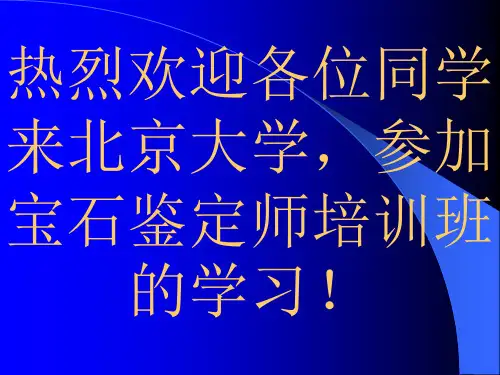
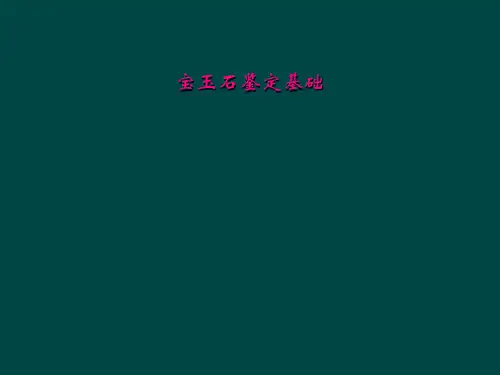
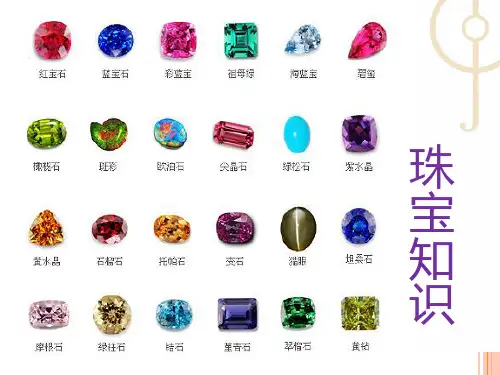
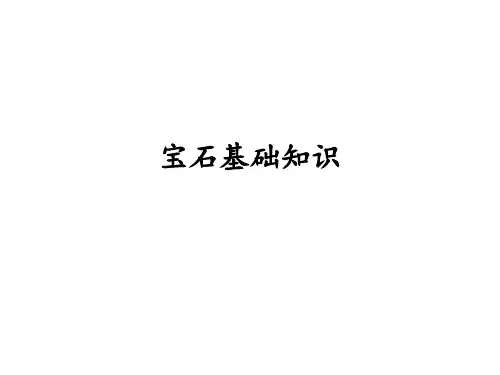
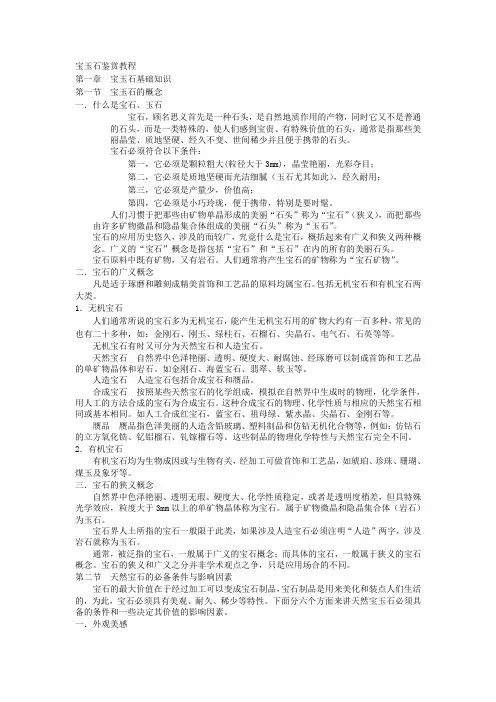
宝玉石鉴赏教程第一章宝玉石基础知识第一节宝玉石的概念一.什么是宝石、玉石宝石,顾名思义首先是一种石头,是自然地质作用的产物,同时它又不是普通的石头,而是一类特殊的,使人们感到宝贵、有特殊价值的石头,通常是指那些美丽晶莹、质地坚硬、经久不变、世间稀少并且便于携带的石头。
宝石必须符合以下条件:第一,它必须是颗粒粗大(粒径大于3mm),晶莹艳丽,光彩夺目;第二,它必须是质地坚硬而光洁细腻(玉石尤其如此),经久耐用;第三,它必须是产量少,价值高;第四,它必须是小巧玲珑,便于携带,特别是要时髦。
人们习惯于把那些由矿物单晶形成的美丽“石头”称为“宝石”(狭义),而把那些由许多矿物微晶和隐晶集合体组成的美丽“石头”称为“玉石”。
宝石的应用历史悠久,涉及的面较广,究竟什么是宝石,概括起来有广义和狭义两种概念。
广义的“宝石”概念是指包括“宝石”和“玉石”在内的所有的美丽石头。
宝石原料中既有矿物,又有岩石。
人们通常将产生宝石的矿物称为“宝石矿物”。
二.宝石的广义概念凡是适于琢磨和雕刻成精美首饰和工艺品的原料均属宝石。
包括无机宝石和有机宝石两大类。
1.无机宝石人们通常所说的宝石多为无机宝石,能产生无机宝石用的矿物大约有一百多种,常见的也有二十多种,如:金刚石、刚玉、绿柱石、石榴石、尖晶石、电气石、石英等等。
无机宝石有时又可分为天然宝石和人造宝石。
天然宝石自然界中色泽艳丽、透明、硬度大、耐腐蚀、经琢磨可以制成首饰和工艺品的单矿物晶体和岩石。
如金刚石、海蓝宝石、翡翠、软玉等。
人造宝石人造宝石包括合成宝石和赝品。
合成宝石按照某些天然宝石的化学组成,模拟在自然界中生成时的物理,化学条件,用人工的方法合成的宝石为合成宝石。
这种合成宝石的物理、化学性质与相应的天然宝石相同或基本相同。
如人工合成红宝石,蓝宝石、祖母绿、紫水晶、尖晶石、金刚石等。
赝品赝品指色泽美丽的人造含铅玻璃、塑料制品和仿钻无机化合物等,例如:仿钻石的立方氧化锆、钇铝榴石、钆镓榴石等。
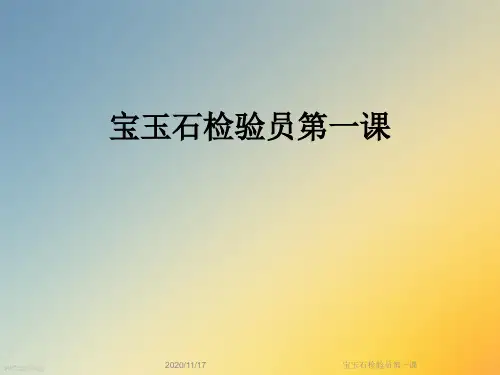
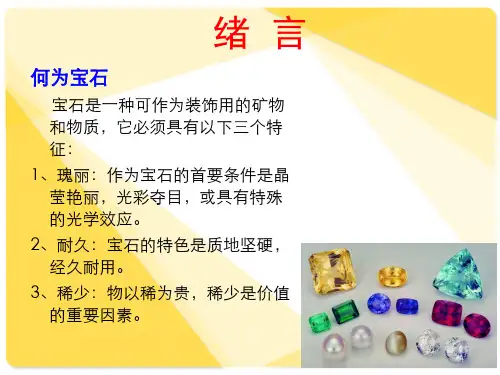
【普及】宝石的基础知识【普及】宝石的基础知识(图文版)<——图文主要来源为中国地质大学《鉴定导论》——>宝石:从目前的宝石学看,宝石的概念有广义和狭义之分。
广义的概念宝石和玉石不分,泛指宝石,指的是色彩瑰丽、晶莹剔透、坚硬耐久、稀少,并可琢磨、雕刻成首饰和工艺品的矿物或岩石,包括天然的和人工合成的,也包括部分有机材料。
狭义的概念有宝石和玉石之分,宝石指的是色彩瑰丽、晶莹剔透、坚硬耐久、稀少,并可琢磨成宝石首饰的单矿物晶体,包括天然的和人工合成的,如钻石、蓝宝石等;而玉石是指色彩瑰丽、坚硬耐久、稀少,并可琢磨、雕刻成首饰和工艺品的矿物集合体或岩石,同样既包括天然的又包括人工合成的,如翡翠、软玉、独山玉、岫玉等。
在商贸或市场销售时,宝石也称珠宝。
顾名思义是指珍珠和宝石,包括珍珠、宝石和玉石等。
颜色:是宝石对不同波长的可见光选择性吸收后,其残余光的混合色即为该宝石的颜色。
1) 色调:相同颜色的宝石,往往在色调上有差异。
如红色宝石有红宝石、红色尖晶石、红色石榴石、红色碧玺等,根据色调上的不同,有助于鉴定宝石。
此主题相关图片2) 色形:颜色的分布状态,有均匀状和不均匀状分布。
此主题相关图片3) 色带:色带是宝石在生长过程中留下的生长痕迹此主题相关图片多色性:在某些具有双折射、有色、透明宝石中看到的不同方向性颜色的通用术语,它包括二色性和三色性。
一轴晶宝石有两个方向性颜色称为二色性,二轴晶宝石有三个方向性颜色称为三色性,统称为多色性。
此主题相关图片此主题相关图片此主题相关图片此主题相关图片透明度:是指宝石透过可见光的能力,透明度与宝石厚度有关。
根据宝石透光的能力可分为透明、半透明、微透明和不透明。
此主题相关图片此主题相关图片此主题相关图片此主题相关图片光泽:投射到宝石表面的光线,有一部分被折射和吸收,另一部分从表面反射,这种反射的光线就构成宝石的光泽。
各种宝石的质地不同,硬度不同,对光吸收、反射的程度也不一样,所以表现的光泽也纷华不一。
珠宝的基本知识珠宝宝石一般民风将金银等金属之外的天然资料(矿物、岩石、生物等)制成的,具有一定价值的首饰、工艺品或其他收藏统称为珠宝,故有“金银珠宝”的说法,策划这些物品的珠宝行也统称为“珠宝行”。
迷信地说,“珠宝”与狭义的“宝石”的概念是相同的。
狭义的宝石泛指那些适宜实行琢磨或琢磨加工为首饰或工艺品的原料。
珠宝大致包括:天然珠宝玉石(天然宝石、天然玉石、天然无机宝石)人为宝石(天然宝石、再造宝石、拼合宝石、分解宝石)还有首饰用贵金属:金、银、铂、钯宝石,必需齐全以下几个特征:听说珠宝销售招聘。
猫眼石“美”,即艳丽明亮,光亮耀眼。
宝石假使不美就不能成为宝石,这种美或浮现为绚丽的颜色,或浮现为透亮而干净,或具特殊的光学效应(如猫眼、变彩、夜光等景象),或具特殊的图案(如菊花石、玛瑙、梅花玉等)。
例宛如为金刚石,透亮少瑕者可用来琢磨成名贵的钻石,而透亮度差、多瑕、色黑者则只能用作工业原料。
“久”,即质地稳固耐磨,能够经久不变。
由于宝石的价值高,人们一按企图它能够经久耐用,可保值乃至世袭的物品。
钻石之所以成为最高贵的宝石,其中一个出处就是它是世界上最硬、又不怕腐蚀的宝石,故世上价值较高的宝石多为一些硬度大、耐腐蚀的硅酸盐矿物(如翡翠)、多数氧化物(如红宝石、蓝宝石)及单质矿物(如钻石),而质软、易受腐蚀的宝石(如岫玉、南边玉等)自己价值较低,常用于创造工艺品,以工取胜;但也有多数宝石不在此列,如欧泊、珍珠。
“稀”,即产量少。
物以稀为贵,世上极为稀奇的祖母绿宝石,上等质量者每克拉(0.2克)价值上万美元,而某些颇大度又可耐“久”的宝石(如紫晶),由于产量较多,开采较便当,其代价不停较低。
某些罕见的岩石,经琢磨后也具好看耐久的特征,想知道珠宝的基本知识。
但却不能成为宝石小家庭中的一员,其出处就是物易得必贱。
珠宝赝品首要是在资料方面作假,以伪劣资料假冒真品,以跻身于高档珠宝之列。
玉缘和珠宝判断师指导:红宝石的判断天然宝石“十红九裂”,没有一点瑕疵及裂纹的天然红宝石极为罕见。
珠宝的定义第一章珠宝的定义1.1宝石的定义1.1.1珠宝宝石定义珠宝玉石--是对天然珠宝玉石(包括天然宝石、天然玉石和有机宝石)和人工宝石(包括合成宝石、人造宝石、拼合宝石和再造宝石)的统称,简称为宝石。
1.1.2天然宝石天然宝石--由自然界产出,具有美观、耐久、稀少性,可加工成饰品的矿物的单晶体(可含双晶)。
宝石三要素:美观、耐久、稀少。
(1)美观:颜色、透明度和纯净度、光泽、特殊的光学效应。
(2)耐久性:硬度、韧度、耐腐蚀性。
(3)稀有性:品种的稀有性(例如紫水晶)和品质的稀有性(例如祖母绿)以及数量的稀少性(例如钻石和绝大部分宝石)。
1.1.3天然玉石天然玉石--由自然界产出的,具有美观、耐久、稀少性和工艺价值的矿物集合体,少数为非晶质体。
与宝石的区别:单晶体和矿物集合体,同样具有美观、耐久、稀少三大特点。
1.1.4天然有机宝石天然有机宝石--由自然界生物生成,部分或全部由有机物质组成,可用于首饰及饰品的材料。
注1:养殖珍珠(简称"珍珠")也归于此类。
1.1.5合成宝石合成宝石--完全或部分由人工制造且自然界有已知对应物的晶质体、非晶质体或集合体,其物理性质、化学成分和晶体结构所对应的天然珠宝玉石基本相同。
1.1.6人造宝石人造宝石--由人工制造且自然界无已知对应物的晶质体、非晶质体或集合体。
1.1.7拼合宝石拼合宝石--由两块或两块以上材料经人工拼合而成,且给人以整体印象的珠宝玉石称拼合宝石,简称"拼合石"。
1.1.8再造宝石再造宝石--通过人工手段将天然珠宝玉石的碎块或碎屑熔接或压结成具整体外观的珠宝玉石。
1.1.9仿宝石仿宝石--用于模仿天然珠宝玉石的颜色、外观和特殊光学效应的人工宝石以及用于模仿另外一种天然珠宝玉石的天然珠宝玉石可称为仿宝石。
"仿宝石"一词不能单独作为珠宝玉石名称。
1.2宝石的分类每一种宝石都有其特定的生成条件、化学成分和内部结构,因而具有一定的反映其个性的形态特征和物理化学性质。
珠宝微课堂第一课——宝石的基本概念What is a gem?
合成水晶能叫人造宝石吗?
亲,先下载这俩个电子书看看吧!!
系统宝石学(二版).pdf http://vdisk.weibo.com/s/4cAtq
珠宝玉石名称2010.pdf http://vdisk.weibo.com/s/fBgOv
请各位亲,仔细看看~~系统宝石学的第1~15页,珠宝玉石名称2010
》珠宝玉石(gems):珠宝玉石是对天然珠宝玉石(包括天然宝石、天然玉石和
天然有机宝石)和人工宝石(包括合成宝石、人造宝石、拼合宝石和再造宝石)
的统称,简称宝石。
》天然珠宝玉石(Natural gems) 由自然界产出,具有美观、耐久、稀少性,具
有工艺价值,可加工成装饰品的物质的统称。包括天然宝石、天然玉石和天然有
机质宝石。
》
1.天然宝石(Natural gemstones)
由自然界产出具有美观、耐久、稀少性,可加工成装饰品的矿物的单晶体(可含
双晶)。
2.天然玉石(Natural jades)
由自然界产出的,具有美观、耐久、稀少性和工艺价值的矿物集合体,少数为非
晶质体。
3.天然有机质宝石(Natural organic substances)
由自然界生物生成,部分或全部由有机物质组成可用于首饰及装饰品的材料为天
然有机质宝石。
• 国标定名规则中,养殖珍珠可以简称“珍珠”,天然珍珠 定名是不能省略“天
然”的。
》
★★★★在普通人眼力,宝石感觉分俩种:玉、水晶。玉其实是所有天然玉石的
统称,包括翡翠、和田玉、黄龙玉、玛瑙类玉石。。。
》
》人工宝石(Artificial products)
完全或部分由人工生产或制造用作首饰及装饰品的材料统称为人工宝石。包括合
成宝石、人造宝石、拼合宝石和再造宝石。
1.合成宝石(Synthetic stones)
完全或部分由人工制造且自然界有已知对应物的晶质或非晶质体,其物理性质,
化学成分和晶体结构与所对应的天然珠宝玉石基本相同。
2.人造宝石(Artificial stones)
由人工制造且自然界无已知对应物的晶质或非晶质体称之。
3.拼合宝石(Composite stones)
由两块或两块以上材料人工拼合而成,且给人以整体印象的珠宝玉石称拼合宝
石,简称“拼合石”。
4.再造宝石(Reconstructed stones)
通过人工手段将天然珠宝玉石的碎块或碎屑熔结或压结成具整体外观的珠宝玉
石。
5.仿宝石(Imitation stones)
用于模仿天然珠宝玉石的颜色、外观和特殊光学效应的人工宝石以及用于模仿另
外一种天然珠宝玉石的天然珠宝玉石可称为仿宝石。
• “仿宝石”不能单独作为珠宝玉石名称。
》》看了电子书,有看不懂的地方,请您留言,或通过投稿的形式和大家一起
交流!《《
你所知道的天然宝石有哪些?
你所知道的天然玉石有哪些?
你所知道的天然有机质宝石有哪些?
你所知道的合成宝石有那些?
你所知道的人造宝石有那些?
更多珠宝知识,请继续关注《珠宝微课堂》
也希望我能和大家一起交流学习
新浪微博:@翌楝Shanky